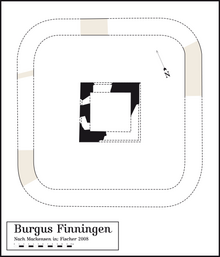
Back Burg Catalan Burgus German Burgus Esperanto Burgo Spanish Burgu (hirigintza) Basque Burgo IO Burgus Italian Burgus Dutch Burgus Polish Бургус Russian







A burgus (Latin, plural burgi ) or turris ("tower")[1] is a small, tower-like fort of the Late Antiquity, which was sometimes protected by an outwork and surrounding ditches. Darvill defines it as "a small fortified position or watch-tower usually controlling a main routeway."[2]
Burgus was a term used in the later period of the Roman Empire, and particularly in the Germanic provinces.[3]
- ^ CIL VIII, 2546; CIL VIII, 2548. Babylonian Talmud, Mo'eds Katan 28b
- ^ Darvill, Timothy (2008). Oxford Concise Dictionary of Archaeology, 2nd ed., Oxford University Press, Oxford and New York, p. 63. ISBN 978-0-19-953404-3.
- '^ CIL III, 3385 and AE 1910, 145
© MMXXIII Rich X Search. We shall prevail. All rights reserved. Rich X Search